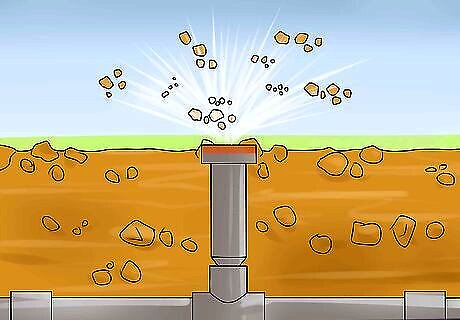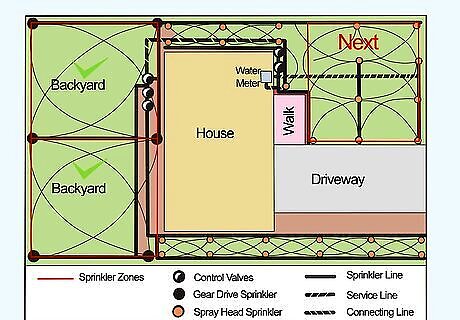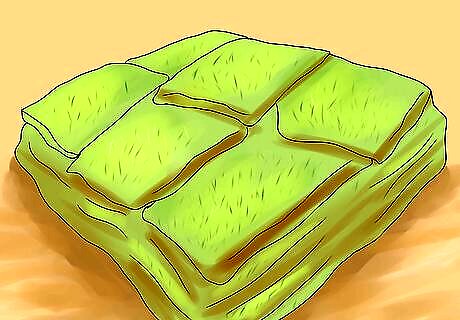
views
Selecting a Sprinkler Type

Choose a gear-driven rotor sprinkler head to cover wide areas. Rotor heads are the most common and versatile type of sprinkler head. They pop up as directed by a timer and revolve 360 degrees in order to spray water across a large area. You can adjust the distance that each head will spray from 8–65 feet (2.4–19.8 m). Gear-driven rotor sprinkler heads are an improved version of the older (and much louder) impact style of rotor sprinklers.

Opt for shrub heads or bubblers to irrigate shrubs and flowers. “Bubbler” sprinkler heads do not elevate above the ground level and, as the name implies, emit a low-level stream of water designed to saturate the ground in a garden or heavily vegetated area. Each bubbler can only irrigate an area of about 3 square feet (0.28 m), so they need to be placed relatively close to each other. Bubbler-type sprinklers only work on flat ground. If you try installing a bubbler on a sloped patch of your yard, you'll end up with a small river running downhill.

Stick with fixed pop-up heads for watering areas adjacent to buildings. If you need to water an area right next to the side of your home or garden shed and would rather that the sprinkler head not blast water all of the building itself, choose a fixed pop-up head. These heads spray water in a half-circle, so you don't have to worry about watering the side of a building. Fixed pop-up head sprinklers are also great to use next to paved areas like driveways and streets.
Mapping out the Sprinkler System

Draw a roughly to-scale diagram of the areas you wish to irrigate. The schematic should include the main area you’d like to water and any adjacent areas you'd like to have covered by the sprinklers. Starting with a schematic will enable you to plan the routing of pipelines and placement of sprinkler heads so you can purchase your materials. Drawing out the area you'd like to irrigate will also ensure that the entire area is covered by the sprinklers.

Divide the areas into rectangles of about 1,200 sq ft (110 m) each. These will be your “zones,” or areas which will be watered as a unit. Consider the type(s) of terrain contained in each zone. For the sake of sprinkler installation, try to limit each zone to 1 type of terrain. For example, 1 zone could be a large, grassy backyard and another could include a garden or sidewalk-side shrubberies. Areas larger than 1,200 square feet (110 m) would require special heads and a higher volume of water than you can normally get from a residential water system.

Mark the location of each sprinkler head on your diagram. Locate the sprinkler heads throughout the areas you’re watering in accordance with the spraying distance of the heads you chose. Mark the to-scale distance that each head will spray onto your schematic. Then, decide which shape you want each head to spray in. A good-quality rotor head will spray an arc, semicircle, or full circle about 25–30 feet (7.6–9.1 m) in diameter. If you’re using rotor heads, situate each head about 45 feet (14 m) apart to allow adequate overlap. Fixed pop-up head sprinklers spray roughly 10 feet (3.0 m). To ensure adequate coverage, install fixed pop-up heads about 18 feet (5.5 m) apart from one another. If you’re installing bubbler sprinkler heads, map them out so that the heads are located about 1.5 feet (0.46 m) apart, since each will cover a radius of roughly 1.75 feet (0.53 m). As a rule of thumb, it’s better to have too much overlap than not enough. Keep in mind when you're positioning the sprinkler heads that the angle of spray on rotor and pop-up heads can be adjusted.

Draw in the main water line. Start the line from the location where you plan to install your control valves, timer (if automatically operated), and backflow preventer. Regardless of where you’re installing the water system, the main line will most likely start from an outdoor water nozzle. Keep in mind that the PVC pipe you’ll use for the water lines can curve only slightly, so all lines must be straight and should turn at 90-degree angles. This portion of the diagram will give you an idea of the length of pipe you’ll need. The sketch can be rough, though.

Draw branch lines from the main line to each head. Branch lines are the smaller pipes that connect the main line to each of the individual sprinkler heads. Sprinkler heads themselves are never attached to the main lines, but always to the branch lines. You can route a branch line to more than 1 head if you use a ⁄4 inch (1.9 cm) pipe, but 2 heads should be the limit. Further down the line, you may decrease the size of the main to ⁄4 inch (1.9 cm), also, since near the end it will be supplying only 2 or 3 heads.
Installing the System

Purchase adequate PVC piping for each irrigation zone. To supply each zone of the area you’re watering, you will need 1 in (2.5 cm) main line pipe and ⁄4 in (1.9 cm) branch line pipe. Refer to your to-scale diagram and measure the distance of main and branch pipe you’ll need. Then visit a local hardware store or home improvement store and purchase the amount of pipe you’ll need. If you’re planning to only attach 1 sprinkler head to each branch line, you could get away with using ⁄2 inch (1.3 cm) pipe.

Measure the pressure of your water supply with a water gauge. Find an outdoor water nozzle, and screw the pressure gauge onto it. Turn the water on full blast and read the psi (pounds per square inch) or kPa (kilopascals) indicator on the face of the water gauge. Most home-sprinkler systems need a water pressure of about 30 pounds per square inch (210 kPa) in order to function. Purchase a water gauge at any hardware store or home improvement store.

Mark the locations for your pipe ditches and heads on your yard. Refer to the to-scale drawing to see where you’ve drawn in the main and branch lines, then head out to your backyard and use a shovel to mark the physical locations where you’ll dig to install the water pipes. Then, when you come to the end of the branch lines, flag the sprinkler-head locations using survey flags. Because you’re using PVC pipe, you don’t need to dig the ditch in a perfectly straight line, as this material will bend fairly easily. Measure all distances with a tape measure to ensure that all of the distances are precise.

Dig the ditches along the main and branch lines marked on the diagram. Use an axe or grubbing hoe to cut the turf, taking care to set it aside in clumps so it can be replaced when you are finished. The ditch should be at least 10 inches (25.4 cm) deep to protect the pipes from damage even in warm climates. If you live in a region that gets frosts during the winter, dig the ditches at least 6 inches (15.2 cm) below the frost level for your area. A trenching shovel may be the best tool to use for this part of the job. Dig carefully so as to avoid your home water lines, exterior lighting circuits, and waste and sewer lines.

Set your PVC piping out in the ditches you just dug. First, place the main PVC line pipe in place so it’s ready to attach to your outdoor water nozzle. Then, set the smaller PVC pipes in place for the branch water lines. Also set into the place the tees, elbows, and bushings for reducing pipe sizes and threading on the sprinkler heads. Depending on the setup you’re using, you may also install funny pipe at this point. “Funny pipe” is a flexible butyl rubber pipe used in sprinkler systems, which has its own unique fittings that slip into the pipes without glue or clamps, and adaptors to thread it into the PVC branch lines and the sprinkler heads. Funny pipe also allows the heads to be adjusted for height and is forgiving if you are prone to driving over the head with a riding lawn mower or vehicle.

Install risers to connect the branch water lines to each sprinkler head. Find the flagging that you stuck into the ground earlier to mark the locations of your sprinkler heads. The risers will connect your water line to these sprinkler heads. Then, attach the risers to the PVC pipe by threading them in place. Before you install the riser, make sure the terminal fitting is the correct thread size for the head.

Connect the main water line to the timer and control valves. Your sprinkler system will come with several control valves and a timer to control when the heads turn on and off. Use PVC funny pipe and the appropriate fittings to connect the main line to the control manifold. “Manifold” is the commonly-used term that describes several valves that are grouped together. Be sure to use the appropriate valve for the type of control you are using.

Attach a backflow preventer to the water supply line. Connect the water supply line into the manifold (time and control valves). Be sure to also attach a backflow preventer so that if the water system loses pressure you will not syphon water from the sprinkler system into the potable water. If you don’t install a backflow preventer, your home’s potable water could be contaminated.

Install the timer unit near an accessible power source. Attach the timer to the wall near a power supply by your front or back door. Set up the unit by connecting the wires coming from the sprinkler valves to the numbered terminals in the timer unit. Test that the timer unit is properly installed and works correctly by manually testing each of the sprinkler zones from the timer control box. You’ll use the timer unit to set and adjust the watering schedule for the sprinkler system. Without a timer unit, your sprinkler system would spray water 24 hours a day.

Turn the control valve on that supplies water to 1 zone. Allow the water pressure to flush the pipes of any debris or dirt which has gotten into them. This should only take 1–2 minutes, but doing this before installing your sprinkler heads will prevent clogged heads later on. Clogged sprinkler heads can be a major headache to clear. So, clearing the pipes at this point can save you time in the long run.

Install your sprinkler heads at the ends of the installed risers. Place the heads according to the locations where you mapped them on the drawn schematic. You can also locate the heads by finding the ends of the risers you installed. Depending on the height of the heads, each should be installed about 6 inches (15 cm) deep. Pack the soil firmly around the heads to hold them in position. Bury the heads deeply enough that the soil will support them and they will be slightly recess below the top of the turf at your preferred mowing height.

Set up the control valve and backflow preventer in the next zone. Once you have successfully installed the sprinkler heads on the first zone, move on to the next zone. Working in sequential order will keep you from overlooking any part of sprinkler system or accidentally forgetting to install a sprinkler head. Continue working zone by zone until you’ve installed the entire system.
Inspecting and Adjusting the Sprinkler System

Observe the spray coverage and direction of each head. Turn the zone valve back on and see how each sprinkler head sprays. If they’re not spraying how you’d like, you can adjust the change the total rotation of gear-drive heads from 0–360 degrees. Also adjust the spray pattern and distance with the adjusting features designed in your particular head. The way you adjust the sprinkler heads can vary from one manufacturer to another. Most have a small radius adjustment knob on the top of the sprinkler head.

Walk the length of your ditches to check for water leaks. Take a close look at the bushings and other fittings to make sure none are leaking water. When you are satisfied there are no leaks, turn the valve off. If you do happen to find a leak, unscrew and reattach the bushings and pipes, taking care to screw them together more tightly this time. It’s important to check for leaks before you shovel the soil back in place over the water lines. If you don’t, you could end up needing to dig up the lines again in the future to find a leak.

Backfill your ditches and pack the soil in firmly. Only backfill the ditches once you’ve walked the ditches and confirmed that there are no leaks. Once you’re certain, use your shovel to scoop the dirt and organic material that you dug out earlier back into the ditches. If you had to remove any sod or other ground cover, place the sod back in place. Shovel up any roots or other organic matter that you unearth while installing the sprinkler pipes. Dispose of these materials in the trash or compost bin.




















Comments
0 comment